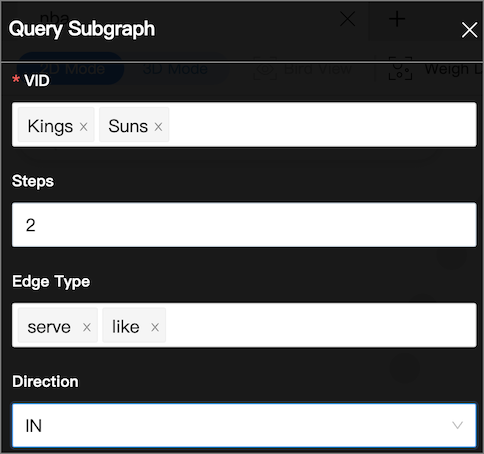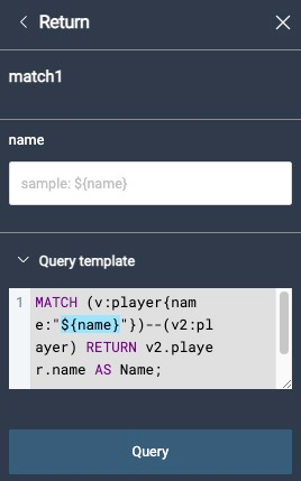Start querying¶
To explore graph data, users need to query some initial data, and based on these initial data, can further analysis and filtering. This topic describes how to query initial data.
Prerequisites¶
Select a target graph space before querying data. For more information, see Choose graph spaces.
Legacy version compatibility
For versions of NebulaGraph below 3.0.0, you need to create an index before querying data. For more information, see Create an index.
Steps¶
Click the Start  icon to query target data on the
icon to query target data on the Explorer page. The queried data will be displayed on the canvas. You have the following ways to query data:
- Query by VID
- Query by Tag
- Query Subgraph
- Query by template
Query by VID¶
You can enter VIDs to query the target vertices.
There are three ways to generate VIDs: Manual input, Random import, and File import.
Note
Only one VID per row is supported in the querying area. Press Enter to separate the VIDs.
The following GIF shows how to query data using the basketballplayer graph space and related data.

Query by Tag¶
You can select the tag and corresponding index to query the target vertices, and set the number of results limit or filter conditions.
Note
Make sure that the corresponding tags and indexes exist in the graph space when querying by tag. For more information, Create tags and Create indexes.
The following example queries 10 players whose age is greater than 30 years old and not equal to 40 years old.

Query Subgraph¶
When querying subgraphs, you can specify the number of steps, edge types, and the direction of inflow and outflow of the subgraph. VID is mandatory. The default value of optional steps is 1, and the default value of optional edge type is all.
Note
When multiple VIDs are entered, the VIDs are separated by the Enter key.
The following is an example of VIDs Kings and Suns, step number 2, and incoming edge types with a VID value of 101, the number of steps of 4, and edge types of server and like.

Query by template¶
You can select the created nGQL template, and set the parameter value.

- When the returned result is vertices, they will be displayed on the canvas.
- When the returned result is not vertices, they will be displayed in table format. For example, return player name, age, etc.
For more information, see nGQL template.